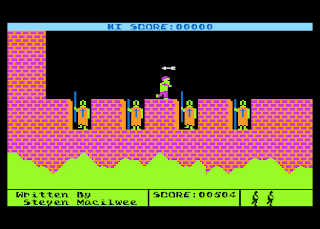Developer: Steven MacIlwee
Publisher: DBM Software
Released: 1985
Castle Top is an action-platformer from the same developer as Speed Run (1988, Atari 8-bit).
It takes place in the year 1502 and your mission as a noble Knight is to rescue your childhood sweetheart Jessica from the clutches of Frederick, Lord of Alconbury. To do this you must climb the castle battlements, jump across platforms and avoid the projectiles and enemies that block your path. Things start off on a bad note as the first screen is extremely tough; here, you need to jump over four gaps while avoiding flaming arrows. This is easier said than done as like many Steven MacIlwee games on Atari 8-bit computers there's a distinct lack of polish. Similar to Leapster (1988) and Winter Wally (1987) the collision detection is atrocious and you can fall off ledges despite having multiple pixels in front of you. Even tapping the d-pad once to turn yourself around usually results in you falling into a pit! It's massively frustrating and you'll die repeatedly as there's only one specific pattern of arrows that will allow you to reach the other side; waiting for this can take forever but at least there's no timer! Afterwards the difficulty decreases slightly as rolling boulders enter the fray but eventually guards start to reside beneath the platform gaps and try to stab you as you jump over them. At times, I did find myself slightly enjoying the brutal challenge as beneath the technical issues there's a really fun action-platformer; it's just a real shame that the game is hampered by the developer's limited programming skills as you'll also have to contend with slowdown and freezing. The graphics are basic with a garish colour scheme and the animation is poor. There's no music to speak of and the only SFX are some terrible ambient white-noises that are supposed to resemble arrows being fired.
Castle Top is a great idea but it never really stood a chance due to insufficient programming skills from its author. In the right hands it could have been a solid action-platformer but instead most people won't be able to stomach the severe difficulty and annoying technical bugs.
Castle Top is a great idea but it never really stood a chance due to insufficient programming skills from its author. In the right hands it could have been a solid action-platformer but instead most people won't be able to stomach the severe difficulty and annoying technical bugs.
Random trivia: The game was later republished by Alternative Software in 1987.






















